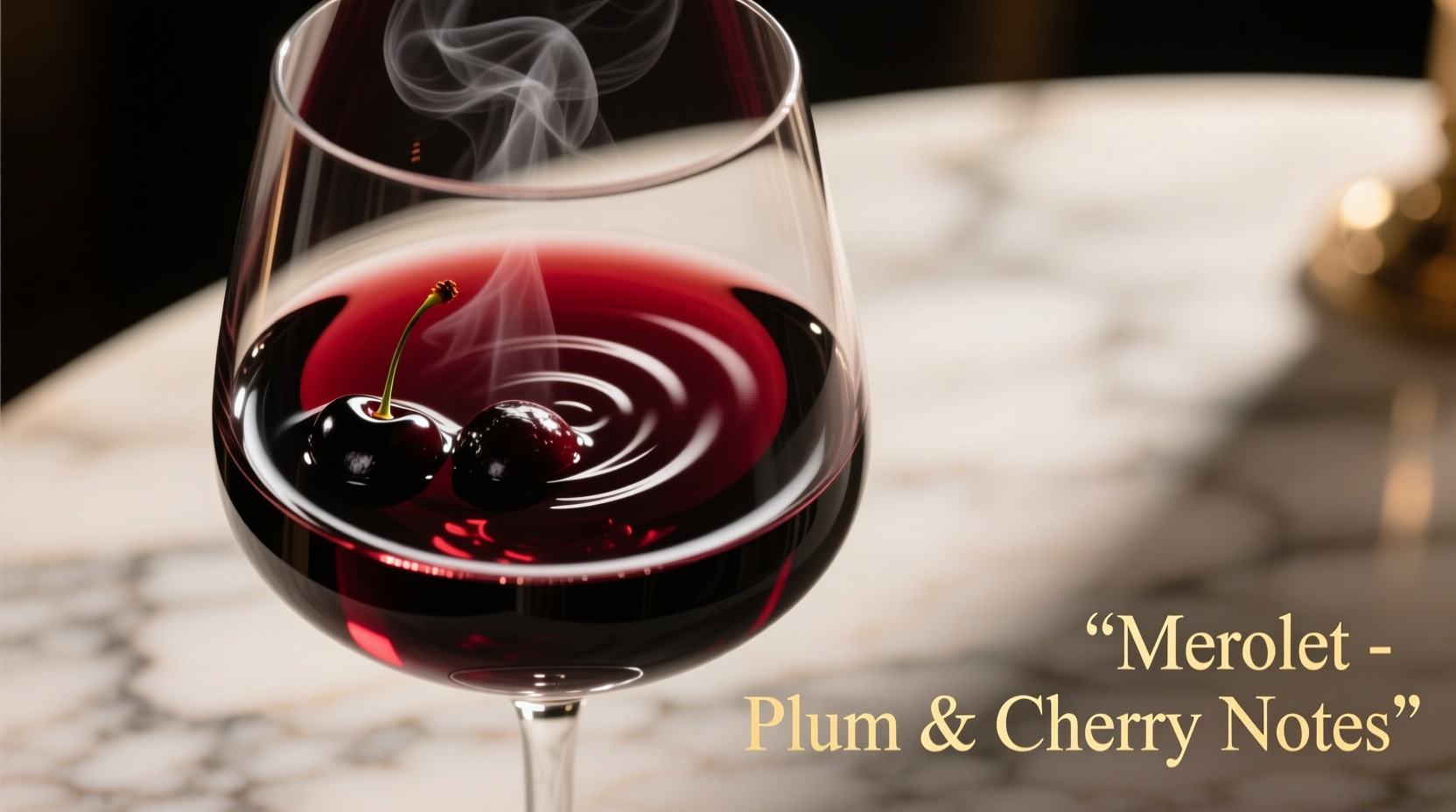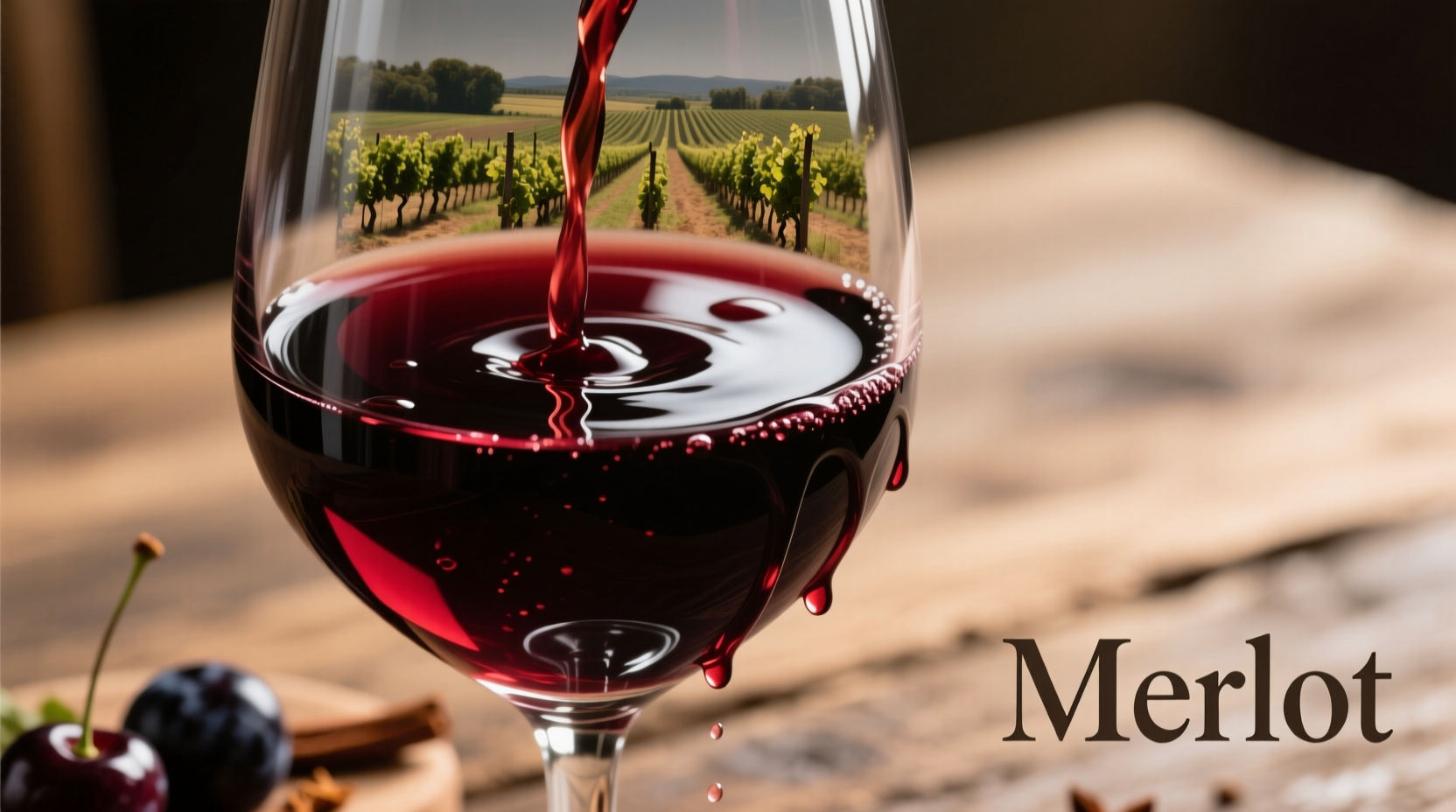Understanding Merlot's distinctive flavor profile helps wine lovers make informed choices whether they're exploring their first red wine or expanding their tasting repertoire. This comprehensive guide breaks down exactly what to expect when you pour a glass of Merlot, why it tastes the way it does, and how to select bottles that match your personal preferences.
Core Flavor Characteristics of Merlot
Merlot's reputation as a "gateway red wine" stems from its balanced, fruit-forward profile that avoids the aggressive tannins found in varieties like Cabernet Sauvignon. When you taste Merlot, you'll typically notice:
- Fruit notes: Ripe plum (the most characteristic), black cherry, blackberry, and sometimes raspberry
- Secondary notes: Chocolate (especially dark chocolate), vanilla (from oak aging), and subtle herbal or leafy undertones
- Mouthfeel: Medium to full body with soft, rounded tannins and moderate acidity
- Finish: Generally smooth and approachable, though premium examples show greater complexity and length
The specific flavor profile varies significantly based on where the grapes are grown. Old World Merlots (from France, particularly Bordeaux) tend to be more structured with earthier notes, while New World Merlots (from California, Washington, Chile) showcase riper fruit flavors and more pronounced oak influence.

How Terroir Shapes Merlot's Taste
Unlike many grape varieties, Merlot expresses dramatic differences based on growing conditions. Understanding these regional variations helps you select bottles that match your taste preferences:
| Region | Flavor Profile | Body & Structure |
|---|---|---|
| Bordeaux, France | Earthy, tobacco, cedar, restrained fruit | Medium body, firm but polished tannins |
| Tuscany, Italy | Red fruit, floral notes, herbal undertones | Medium body, bright acidity |
| California, USA | Ripe plum, black cherry, chocolate, vanilla | Full body, soft tannins, higher alcohol |
| Washington State, USA | Blackberry, blueberry, baking spices | Full body with better acidity than California |
| Chile | Plum, blackberry, subtle oak | Medium-full body, smooth texture |
According to research from the University of California, Davis Department of Viticulture and Enology, Merlot's thinner skin and earlier ripening compared to Cabernet Sauvignon results in lower tannin levels and a naturally softer profile. This structural difference fundamentally shapes what Merlot tastes like compared to other Bordeaux varieties.
Merlot's Evolution: From Supporting Player to Star
Merlot's flavor perception has changed dramatically over time. Originally used primarily as a blending grape in Bordeaux, Merlot gained standalone popularity in the late 20th century:
- Pre-1980s: Primarily a blending component in Bordeaux wines, valued for its softening effect on Cabernet Sauvignon
- 1980s-1990s: Rose to prominence as a single-varietal wine, particularly in California where winemakers created fruit-forward styles
- Early 2000s: Experienced backlash after being featured in the film Sideways, with many consumers mistakenly believing it was inferior
- Present day: Winemakers have refined their approach, creating more balanced, terroir-expressive Merlots that have regained critical acclaim
Wine Spectator's analysis of tasting data shows Merlot's average quality scores have increased by 8 points over the past 15 years as producers focused on better vineyard sites and more thoughtful winemaking techniques. This evolution directly impacts what Merlot tastes like today compared to wines from previous decades.
Practical Tasting Guide: How to Experience Merlot's Flavors
To fully appreciate what Merlot tastes like, follow these professional tasting techniques:
- Temperature: Serve at 60-65°F (15-18°C) - slightly cooler than room temperature
- Glassware: Use a standard red wine glass with a large bowl to allow the aromas to develop
- Visual examination: Note the deep ruby to garnet color (older Merlots develop brick-red edges)
- Nosing technique: Swirl gently and take short, quick sniffs to identify primary fruit aromas before deeper notes emerge
- Tasting method: Take a small sip, let it coat your palate, then breathe air over the wine to release additional flavors
Pay particular attention to the mid-palate transition - this is where Merlot's characteristic plum flavors typically emerge before giving way to the smooth finish. Unlike more tannic reds, Merlot shouldn't leave your mouth feeling dry or grippy.
Perfect Food Pairings for Merlot
Merlot's balanced profile makes it remarkably food-friendly. Consider these pairing suggestions based on what Merlot tastes like:
- Classic pairings: Roast chicken, pork tenderloin, duck breast, mushroom risotto
- Cheese matches: Aged cheddar, gouda, fontina, mild blue cheeses
- Pasta partners: Tomato-based sauces, mushroom ragù, truffle pasta
- Avoid: Very spicy dishes or delicate seafood that might be overwhelmed
The key to successful pairing is matching the wine's weight and flavor intensity with your dish. Lighter-bodied Old World Merlots work well with poultry and mushrooms, while fuller-bodied New World styles complement grilled meats and richer sauces.
Choosing Your Perfect Merlot
Not all Merlots taste the same. Use these guidelines to find bottles matching your preferences:
- If you enjoy sweetness perception: Look for California or Chilean Merlots with ripe fruit flavors (though technically dry, these show more fruit-forward characteristics)
- If you prefer earthy complexity: Choose Bordeaux blends or Italian Merlots with higher acidity
- If you want immediate drinkability: Select current vintage Merlots from Washington State or Argentina
- If you appreciate age-worthy structure: Invest in premium Pomerol or Saint-Émilion bottlings
Remember that vintage matters significantly for Merlot. According to the Wine Institute, cooler vintages produce Merlots with brighter acidity and more herbal notes, while warmer years yield riper, fruit-driven styles. Checking vintage charts helps you understand what to expect from specific releases.
Frequently Asked Questions
Here are answers to common questions about Merlot's taste profile:
Is Merlot sweeter than Cabernet Sauvignon?
No, Merlot isn't technically sweeter than Cabernet Sauvignon as both are dry wines. However, Merlot's riper fruit profile, lower tannins, and sometimes higher alcohol content create a perception of sweetness that makes it seem fruitier and more approachable to many drinkers.
Why does some Merlot taste like chocolate?
The chocolate notes in Merlot come from two sources: the natural phenolic compounds in the grape itself and oak aging. When Merlot is aged in oak barrels (particularly American oak), it develops flavors reminiscent of cocoa, mocha, and dark chocolate. Cooler climate Merlots often show more milk chocolate notes, while warmer region examples display darker chocolate characteristics.
Does Merlot need to breathe before drinking?
Most everyday Merlots benefit from 15-30 minutes of aeration to soften any remaining tannins and allow the fruit flavors to emerge. Premium, age-worthy Merlots (particularly Bordeaux examples) may need 1-2 hours of breathing time to fully express their complexity. However, very old Merlots (15+ years) might deteriorate quickly with too much air exposure.
How does Merlot's taste change as it ages?
Young Merlot showcases primary fruit flavors like plum and black cherry. As it ages (typically 5-15 years for quality examples), it develops tertiary notes of leather, tobacco, forest floor, and dried fruit while the tannins soften. The color evolves from deep purple to brick red. Well-aged Merlot gains complexity while maintaining its characteristic smoothness, creating a more nuanced drinking experience.
Can Merlot taste like green bell pepper?
While Cabernet Sauvignon is famous for pyrazines that create green bell pepper notes, Merlot can show similar characteristics when harvested underripe or grown in cooler climates. However, this is generally considered a flaw in Merlot as the variety is prized for its ripe fruit profile. Quality Merlot should show minimal vegetal notes, focusing instead on plum and berry characteristics.











 浙公网安备
33010002000092号
浙公网安备
33010002000092号 浙B2-20120091-4
浙B2-20120091-4